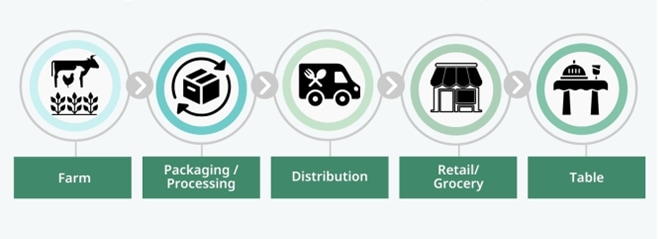Feeding the future: Food supply chain trends 2024
Visit BSI's Experts Corner: Home for insights from BSI’s practice directors and industry experts on digital trust, environmental, health, safety, security, and sustainability.
January 30, 2024 - The global food supply chain has seen a fair share of disruption in recent years. As we move through 2024, economic, environmental, and geopolitical factors will continue to have knock-on effects to the food supply chain, resulting in cargo theft, agricultural challenges, and increased food insecurity at any point down the line.

Four trends we expect to see through 2024 include:
Inflation fueling cargo theft
Inflation is a significant contributor to the ongoing issue of food cargo theft as society and households struggle to make ends meet. From December 2022 to 2023, food prices in the US increased by 2.7 percent, and signs point toward these figures decelerating but not decreasing in 2024.
Though food prices remain high, production issues mean that some products are experiencing more severe price spikes. The European Commission reports that in September 2023, olive oil prices had increased by 75 percent since January 2021 and are expected to consistently rise in 2024. This price hike has resulted in higher product theft, particularly in the production countries of Spain, Italy, Turkey, and Greece.
Weakening agricultural yields
Adverse weather events affected crop production in multiple regions of the world through 2023. For example, in July 2023, the Italian region of Sicily reported that heatwaves and wildfires had resulted in over 200 million euros of damage to the regional agricultural industry.
Globally, agricultural producers and suppliers are bracing for more flooding, hail, fires, and extreme temperature incidents in 2024. These threats, much like the one in Italy, may lead to further food theft and a breeding ground for counterfeiting.
To mitigate the damage caused by climate-related events, climate-smart agriculture could be a game changer for farmers. New technologies offer a range of tools and systems, including precision irrigation and sensors, to monitor water levels and temperature conditions, allowing farmers to prepare for potential challenges and increase diminishing yields.
International trade practices
Global ESG regulations have increased dramatically, rising 155 percent in the past decade. Regulations will continue to transform food and beverage supply chains as companies adapt to meet new ESG reporting requirements, especially in the European Union. These requirements will shape the industries in other countries as export markets work toward compliance. Some regulations include the Regulation on Deforestation-free products, the Proposal for a ban on goods made using forced labour, and the Directive on Green Claims.
There’s growing backlash on “shrinkflation,” a practice that often affects food products, in which the quantity of a given product decreases or the product is reformulated with cheaper ingredients though the price stays the same or increases. One popular French grocery chain has begun putting up signs in its stores to warn against products that exhibit shrinkflation, while the Korean government is considering a mandate that would obligate companies to notify customers of decreases in product sizes.
Challenges destabilizing supply lines
Global incidents such as the attacks on ships in the Red Sea have led to shifting supply lines and higher shipping costs, which has exacerbated global food insecurity and price increases. The immediate near-halt of grain from Ukraine has had substantial implications for global food security, with hundreds of millions of people facing hunger globally despite some improvements in the situation.
Challenges in the Red Sea and nearby regions have prompted shipping companies to reroute shipments. This has impacted nearly 15 percent of global maritime trade, leading to increased costs for maritime shipping. Companies are now exploring alternative freight-transport methods such as air and rail. Global trade disruptions can influence food prices, sparking concerns that this issue will also contribute to food price increases and insecurity.
These persistent obstacles underscore the importance of organizations taking a holistic approach to understanding risks and the knock-on effects to food supply chains. Despite these daunting challenges, companies can mitigate threats more effectively by taking a proactive approach and instituting the right standards and policies across the whole of their organization.
For a look at the state of the global supply chain, keep an eye out for BSI’s 2024 supply chain risk insights report.
This article was originally published by Food Logistics under the title State of the Industry: Top 10 Trends to Shape Cold Food Chain in 2024 on December 4, 2023. Read more from Erica in Takeaways from BSI Connect SCREEN’s Quarterly Risk Intelligence Outlook: Part 2.
Visit BSI’s Experts Corner for more insights from industry experts. Subscribe to our Experts-Corner-2-Go LinkedIn newsletters for a fortnightly roundup of the latest thought leadership content: Digital trust, EHS, supply chain.





